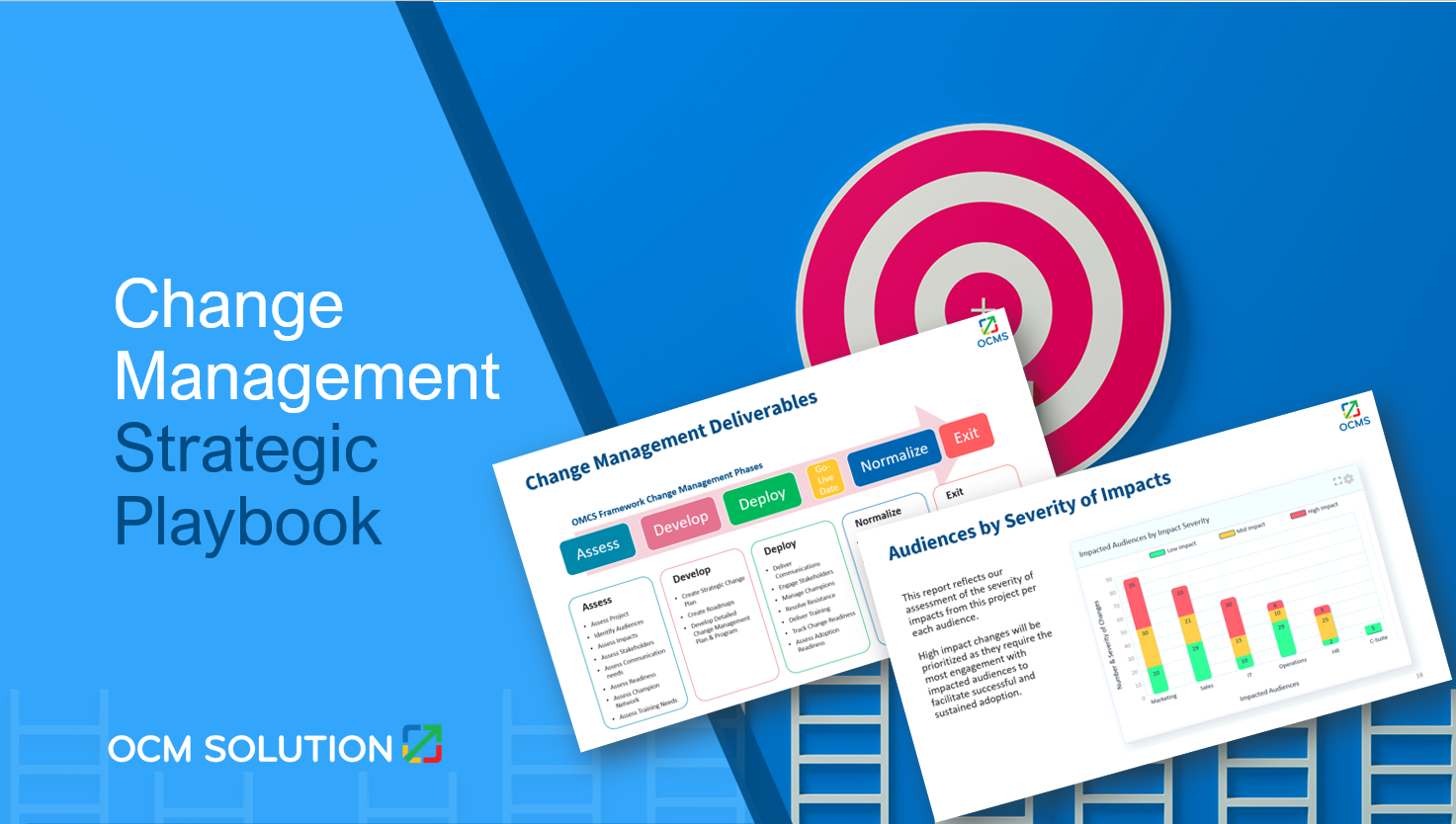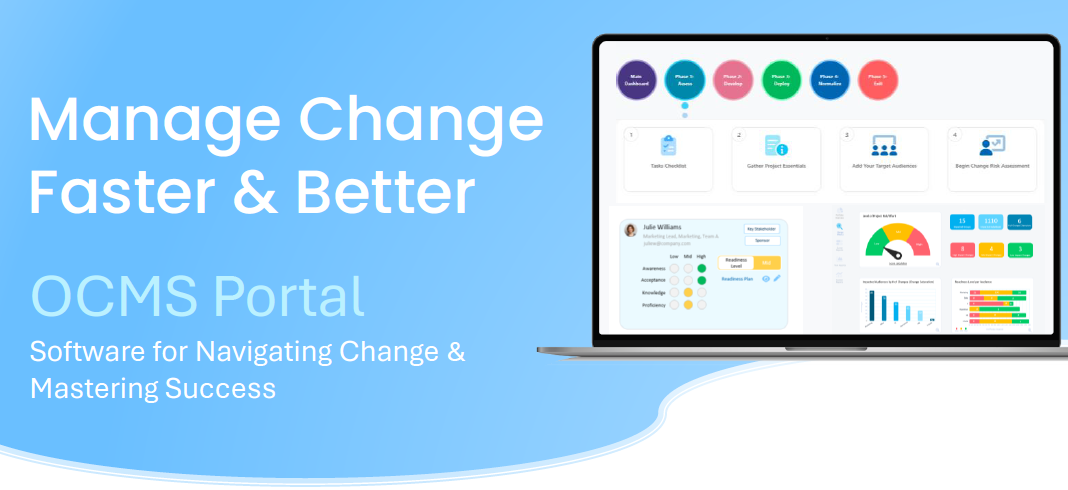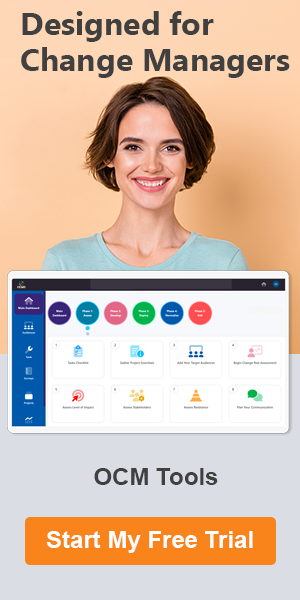A Proven Process for Managing Change in Organizations
Change. It’s a constant in our lives, both personally and professionally. In the always-evolving world of business, change isn’t just inevitable, it’s essential for survival and growth. But navigating organizational change effectively can be a complex dance, one that requires a skilled change manager as your lead.
This article delves into the world of the organizational change process, equipping you with proven strategies to not only manage change initiatives but to master them. We’ll explore a range of tactics, from building a strong foundation to measuring success, ensuring your organization embraces change with confidence and thrives in the face of transformation.
Watch a summary below:
Story Highlights
|

Change Management Defined
Change management involves thoughtful planning and sensitive implementation, and above all, consultation with, and involvement of, the people affected by the changes. If you force change on people, problems will arise. Change must be realistic, achievable, and measurable.
The first step in mastering the organisational change process is understanding the types of change that can occur within an organization:
- Developmental Change: This occurs when you make an improvement to an existing process or system.
- Transitional Change: This happens when you replace existing processes or systems with new ones.
- Transformational Change: This takes place when you make a fundamental change in the way your organization operates.
When managing change in the workplace, recognizing the type of change – developmental, transitional, or transformational – is crucial for effective change management.
Each category demands a distinct approach. Developmental changes are incremental improvements, requiring clear communication and training. Transitional changes replace existing systems, necessitating a focus on minimizing disruption and ensuring smooth adoption. Transformational changes, the most complex, require a complete cultural shift. Here, understanding the “why” behind the change and fostering a sense of shared vision are paramount.
By pinpointing the type of change, those leading organizational change can tailor their strategies, resource allocation, and communication styles for optimal success.
Understanding the Landscape: The Cornerstones of Change Management
Before delving into specific strategies to manage change management, let’s establish a solid foundation. Change management is a structured approach to leading organizational transitions. It’s about more than just implementing new processes; it’s about guiding people through the emotional and cultural shifts that accompany change.
Here are the cornerstones of effective change management:
- Understanding the Need for Change: Clearly define the “why” behind the change initiative when managing change in business. What problem are you trying to solve? What opportunity are you trying to capture?
- Identifying Stakeholders: Pinpoint everyone impacted by the change, from employees at all levels to external partners and clients. This group is often referred to as your Target Audience, and it’s at the center of leading change management for a project.
- Building a Shared Vision: Craft a clear and compelling vision for the future state of the organization post-change.
- Effective Communication: Keep stakeholders informed, engaged, and addressed throughout the process. Transparency and clear communication are key to building trust.
Do you have additional questions related to our sections on change management defined or managing change organization priorities? Please reach out and let us know. We’re happy to help!
Strategies for Leading and Managing Change
Navigating the turbulent waters of organizational change demands a nuanced approach that blends foresight, adaptability, and effective leadership. In this section, we delve into an array of strategies meticulously crafted to guide organizations through the intricate process of transformation.
From implementing robust communication channels to fostering a culture of resilience, these strategies serve as compass points for managing change management. They direct leaders and teams toward sustainable success amidst dynamic landscapes.
Whether it’s technological innovation, shifts in market demands, or internal restructuring, the insights offered here aim to empower organizations to not only weather change but to emerge stronger, more agile, and poised for continued growth.
Here are some proven strategies that can help you manage change management effectively:
Communicate Clearly
Communication is a key element in change management. You need to communicate the reasons for the changes, the benefits, and the details of the change itself.
Managing through change successfully necessitates a proactive approach to OCM communications planning. When there is a lack of information about upcoming changes that impact employees, they will often fill that void with negative perceptions of what change will mean for them and their teams.
Managing a team through change with timely and proactive communications helps calm nerves, and gives people the information they need to adapt to the transition successfully.
Involve Stakeholders
It’s important to involve all stakeholders in the change process. This includes employees, customers, suppliers, and any other parties who will be affected by the change.
How do you know who is in this target audience of stakeholders? An important early step in managing change organization priorities is the change impacts assessment. Change management defined this assessment as one that looks at the groups being impacted by a project – meaning their “current state” is changing to a different “future state” (such as needing to adopt a new business application).
Once the groups and individuals in those groups are identified, the level of impact is determined to prioritize them for the organizational change process.
Plan Thoroughly
A well-thought-out plan is essential for successfully managing change in the workplace. The plan should include timelines, resources needed, and potential risks.
There are typically two pieces to this plan to manage change management:
- OCM Strategic Playbook: This is a high-level roadmap that outlines the overall vision, goals, and key strategies for your change initiative. Think of it as the blueprint you’ll share with key leaders on your plans for leading change management for the initiative.
- OCM Plan: This is a more detailed, action-oriented document that translates the strategic playbook into concrete steps. It outlines specific activities, timelines, communication plans, and resource allocation for each stage of the organisational change process.
Provide Training
In times of change, knowledge is empowerment. People need not only to comprehend the why behind the change but also the how. Providing comprehensive training programs as part of managing change in business equips employees with the necessary skills and knowledge to effectively implement the proposed changes.
Support Your Team
Change can be a challenging journey, often accompanied by uncertainty and resistance. Recognizing the emotional impact of change, it’s crucial for those leading and managing change to provide unwavering support to their teams.
This support can manifest in various forms, including open communication channels, empathetic leadership, and access to resources both before and after a project goes live. By demonstrating empathy and solidarity, those leading organizational change can foster a sense of trust and resilience, facilitating a smoother transition process.
Monitor Progress
Managing change management for an initiative is an ongoing process that requires vigilant monitoring and assessment. Regularly tracking the progress of the impacted stakeholders allows leaders to identify potential roadblocks, gauge the effectiveness of implemented strategies, and make timely adjustments as needed.
By establishing key performance indicators (KPIs) and feedback mechanisms, leaders managing through change can ensure transparency, accountability, and continuous improvement throughout the change journey.
The Role of Leadership in Change Management
Leadership is crucial when managing a team through change. Change leaders must be able to:
- Create a Vision: Leaders must create a clear vision of what the change will achieve.
- Lead by Example: Leaders should be the first to embrace the change and show others how it’s done.
- Encourage Engagement: Leaders should encourage their team to engage with the change and contribute their ideas.
- Address Resistance: Leaders must be prepared to address any resistance to change positively and constructively.
Those who manage change management (change practitioners, change managers, OCM teams) should work with leaders to help them understand and fill their roles.
Conclusion: Managing the Organizational Change Process
Mastering the art of change is not easy, but it is possible with the right strategies and approach. By understanding change management and implementing proven strategies, you can ensure that your organization navigates change successfully. Remember, change is not just about processes and systems; it’s about people. The more you involve and support your people, the more successful your efforts in managing change in the workplace will be.
Tools to Help You Manage Change Management
Leading and managing change can be either confusing or comprehensive and straightforward. Are you tired of struggling with spreadsheets? Wish you had a single place to keep all your change management activities and resources?
Try OCMS Portal by OCM Solution. This all-in-one solution to manage change management is easy to use and walks teams through a comprehensive process.
Learn more and sign up for a free trial today!
FAQ – Managing Change in Business
What are the cornerstones of effectively managing change management?
To manage change management successfully, there are four key principles:
- Understanding the Need for Change
- Identifying Stakeholders.
- Building a Shared Vision
- Effective Communication
What are some strategies for managing change in the workplace?
Here are a few key strategies for managing change organization initiatives effectively:
- Provide clear and consistent communication about the reasons for the change, the benefits, and the details.
- Engage all stakeholders in the change process.
- Develop a well-thought-out plan with timelines, resources, and potential risks identified.
- Train employees on the necessary skills and knowledge to implement the changes.
- Recognize the emotional impact of change and provide ongoing support to your team throughout the process.
What tools can help me manage change management more easily?
OCMS Portal is a leading software available to support organizational change processes. These tools can help you assess, plan, track progress, and ensure a smooth transition for your organization.
Note: Content on OCM Solution's ocmsolution.com website is protected by copyright. Should you have any questions or comments regarding this OCM Solutions page, please reach out to Ogbe Airiodion (Change Management Lead) or the OCM Solutions Team today. OCM Solution was previously known as Airiodion Global Services (AGS).
External Sources: stock.adobe.com





